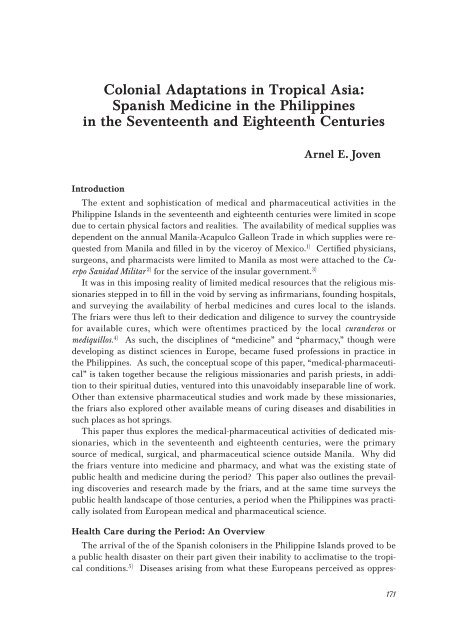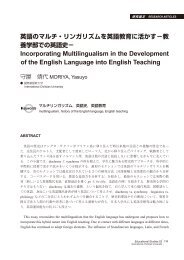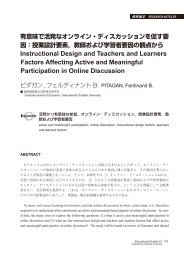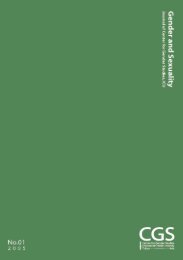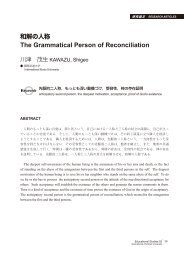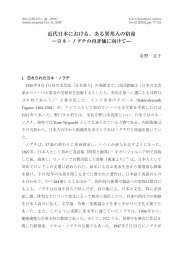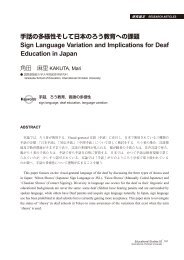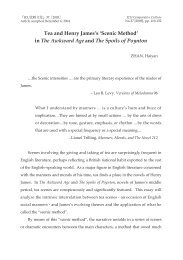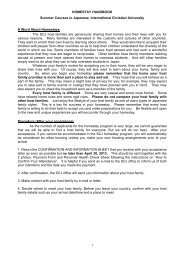Colonial Adaptations in Tropical Asia: Spanish Medicine ... - icu.ac.jp
Colonial Adaptations in Tropical Asia: Spanish Medicine ... - icu.ac.jp
Colonial Adaptations in Tropical Asia: Spanish Medicine ... - icu.ac.jp
Create successful ePaper yourself
Turn your PDF publications into a flip-book with our unique Google optimized e-Paper software.
<strong>Colonial</strong> <strong>Adaptations</strong> <strong>in</strong> <strong>Tropical</strong> <strong>Asia</strong>:<br />
<strong>Spanish</strong> Medic<strong>in</strong>e <strong>in</strong> the Philipp<strong>in</strong>es<br />
<strong>in</strong> the Seventeenth and Eighteenth Centuries<br />
Introduction<br />
The extent and sophistication of medical and pharmaceutical activities <strong>in</strong> the<br />
Philipp<strong>in</strong>e Islands <strong>in</strong> the seventeenth and eighteenth centuries were limited <strong>in</strong> scope<br />
due to certa<strong>in</strong> physical factors and realities. The availability of medical supplies was<br />
dependent on the annual Manila-Acapulco Galleon Trade <strong>in</strong> which supplies were requested<br />
from Manila and filled <strong>in</strong> by the viceroy of Mexico. 1) Certified physicians,<br />
surgeons, and pharmacists were limited to Manila as most were attached to the Cuerpo<br />
Sanidad Militar 2) for the service of the <strong>in</strong>sular government. 3)<br />
It was <strong>in</strong> this impos<strong>in</strong>g reality of limited medical resources that the religious missionaries<br />
stepped <strong>in</strong> to fill <strong>in</strong> the void by serv<strong>in</strong>g as <strong>in</strong>firmarians, found<strong>in</strong>g hospitals,<br />
and survey<strong>in</strong>g the availability of herbal medic<strong>in</strong>es and cures local to the islands.<br />
The friars were thus left to their dedication and diligence to survey the countryside<br />
for available cures, which were oftentimes practiced by the local curanderos or<br />
mediquillos. 4) As such, the discipl<strong>in</strong>es of “medic<strong>in</strong>e” and “pharmacy,” though were<br />
develop<strong>in</strong>g as dist<strong>in</strong>ct sciences <strong>in</strong> Europe, became fused professions <strong>in</strong> practice <strong>in</strong><br />
the Philipp<strong>in</strong>es. As such, the conceptual scope of this paper, “medical-pharmaceutical”<br />
is taken together because the religious missionaries and parish priests, <strong>in</strong> addition<br />
to their spiritual duties, ventured <strong>in</strong>to this unavoidably <strong>in</strong>separable l<strong>in</strong>e of work.<br />
Other than extensive pharmaceutical studies and work made by these missionaries,<br />
the friars also explored other available means of cur<strong>in</strong>g diseases and disabilities <strong>in</strong><br />
such places as hot spr<strong>in</strong>gs.<br />
This paper thus explores the medical-pharmaceutical activities of dedicated missionaries,<br />
which <strong>in</strong> the seventeenth and eighteenth centuries, were the primary<br />
source of medical, surgical, and pharmaceutical science outside Manila. Why did<br />
the friars venture <strong>in</strong>to medic<strong>in</strong>e and pharmacy, and what was the exist<strong>in</strong>g state of<br />
public health and medic<strong>in</strong>e dur<strong>in</strong>g the period? This paper also outl<strong>in</strong>es the prevail<strong>in</strong>g<br />
discoveries and research made by the friars, and at the same time surveys the<br />
public health landscape of those centuries, a period when the Philipp<strong>in</strong>es was practically<br />
isolated from European medical and pharmaceutical science.<br />
Health Care dur<strong>in</strong>g the Period: An Overview<br />
Arnel E. Joven<br />
The arrival of the of the <strong>Spanish</strong> colonisers <strong>in</strong> the Philipp<strong>in</strong>e Islands proved to be<br />
a public health disaster on their part given their <strong>in</strong>ability to acclimatise to the tropical<br />
conditions. 5) Diseases aris<strong>in</strong>g from what these Europeans perceived as oppres-<br />
171
sive tropical climate and virtually alien ecological landscape plagued the ranks of<br />
the <strong>Spanish</strong> civil and military personnel assigned to the islands. Unfortunately,<br />
medical facilities and resources were limited to Manila as medical, surgical, and<br />
pharmaceutical needs depended on overseas supply transactions, specifically from<br />
New Spa<strong>in</strong>. To make matters worse, the local population suffered from different<br />
k<strong>in</strong>ds of ailments with which the Spaniards could offer abundant spiritual consolation<br />
but only limited physical respite. In this reality, alternative solutions had to be<br />
sought out. 6)<br />
With<strong>in</strong> the area of Manila and its surround<strong>in</strong>g districts, the <strong>Spanish</strong> missionaries,<br />
primarily the Franciscans, founded hospitals catered to the local population as the<br />
established royal hospitals <strong>in</strong> Manila and Cavite were solely reserved for <strong>Spanish</strong><br />
patients (see Table 1). 7) The Dom<strong>in</strong>icans, hav<strong>in</strong>g been charged with the conversion<br />
of the Ch<strong>in</strong>ese, founded a hospital for the use of the Ch<strong>in</strong>ese patients <strong>in</strong> the Parian<br />
district. 8) The Franciscans also established hospitals <strong>in</strong> Laguna and <strong>in</strong> Nueva Caceres<br />
to cater to the needs of ail<strong>in</strong>g Filip<strong>in</strong>o patients (see Table 1). 9)<br />
The prov<strong>in</strong>cial health care system though of the early Filip<strong>in</strong>os for the most part<br />
of the early <strong>Spanish</strong> colonial period revolved and depended upon the ability of the<br />
local curandero or matanda to provide the necessary cure for ail<strong>in</strong>g patients. 10) At<br />
times, such cures proved effective enough. For the most part though, the therapeutic<br />
process <strong>in</strong>volved supernatural <strong>in</strong>vocations, which def<strong>in</strong>itely <strong>in</strong>curred the disapproval<br />
of the religious missionaries. Nonetheless, the padres from the different religious orders<br />
sought an unofficial alliance with these local practitioners, learn<strong>in</strong>g from their<br />
arts, while officially condemn<strong>in</strong>g these mediquillos as superstitious quacks.<br />
It was not long before the friars themselves mastered the herbal science they<br />
needed <strong>in</strong> order to apply such knowledge <strong>in</strong>to practice as physicians to the people<br />
suffer<strong>in</strong>g from various diseases and/or disabilities. Other than botanical cures, the<br />
friars also utilised natural hydrotherapy and rudimentary surgery for their patients,<br />
although it must be understood that they were primarily spiritual m<strong>in</strong>isters and not<br />
lay or secular-tra<strong>in</strong>ed scientists or medical practitioners. For the most part of the<br />
seventeenth and eighteenth centuries, local medic<strong>in</strong>e revolved around the parish<br />
priests and the local therapists.<br />
Imported Drugs and Medic<strong>in</strong>es<br />
The prevail<strong>in</strong>g knowledge on medical and pharmaceutical science dur<strong>in</strong>g the period<br />
depended on European-tra<strong>in</strong>ed physicians and pharmacists who were mostly<br />
concentrated <strong>in</strong> Manila. Their knowledge thus required formulations obta<strong>in</strong>able<br />
from Europe or at least from Lat<strong>in</strong> America. The geographic expanse of the Philipp<strong>in</strong>es<br />
from the west proved to be the greatest challenge that <strong>in</strong>itially beset westerneducated<br />
medical practitioners <strong>in</strong> the islands.<br />
Drugs and Medic<strong>in</strong>es Imported from Mexico<br />
Drugs and medic<strong>in</strong>es were primarily imported from Mexico through the galleon<br />
trade. Ostwald C. Sales (2005) discusses amply <strong>in</strong> his article how drugs and medic<strong>in</strong>e<br />
supplies were procured. 11) The governor, as vice royal patron compiles the procurement<br />
lists sent by the religious, and sends these documents to the viceroy who<br />
172
Table 1. Early Major <strong>Spanish</strong> Hospitals <strong>in</strong> the Philipp<strong>in</strong>es<br />
Hospital LifeSpan Adm<strong>in</strong>istrators Patients Location<br />
Hospital Real de Españoles [Royal 1577–1898 Franciscans <strong>Spanish</strong> soldiers, Manila<br />
<strong>Spanish</strong> Hospital]<br />
(1577–1636, sailors, and<br />
1644–1704)<br />
lay or government<br />
(1636–1644,<br />
1704–1898)<br />
civilians<br />
Hospital de los Indios Naturales [Hos- 1578–1603 Franciscans Natives and Manila<br />
pital of Native Indians]/<br />
foreigners who<br />
Hospital de Santa Ana [St. Anne 1603–present<br />
could not afford<br />
Hospital]<br />
medical services at<br />
home<br />
Hospital de la Misericordia [Mercy 1578–1656 Brotherhood of the Natives and Manila<br />
Hospital]/<br />
Misericordia foreigners who<br />
Hospital de San Juan de Dios [St. 1656–present (1578–1656) could not afford<br />
John of God Hospital]<br />
B. San Juan de Dios medical services at<br />
(1656–1865)<br />
Daughters of Charity<br />
(1865–present)<br />
home<br />
Hospital de los Indios Naturales [Hos- 1578–1603 Franciscans leprosy patients Manila<br />
pital of Native Indians]/<br />
(1578–1899)<br />
Hospital de San Lazaro [Hospital of<br />
St. Lazarus]<br />
1603–present<br />
Hospital del Espiritu Santo [Holy 1591–1662 Franciscans sailors, mar<strong>in</strong>es, Cavite<br />
Spirit Hospital]<br />
(1591–1636, ship-builders,<br />
1640–1662)<br />
lay or government<br />
(1636–1640)<br />
carpenters, etc.<br />
Hospital de Santiago [St. James’ 1611–1691 Franciscans anyone Naga<br />
Hopsital]/<br />
(1611–1691)<br />
Hospital de San Lazaro [Hospital of 1873–present lay or government<br />
St. Lazarus]<br />
(1873–present)<br />
Hospital de San Pedro Martir [St. Pe- 1587–1599 Dom<strong>in</strong>icans Ch<strong>in</strong>ese Manila<br />
ter the Martyr Hospital]/<br />
(1587–1774)<br />
B<strong>in</strong>ondo<br />
Hospital de San Gabriel [St. Gabriel 1599–1774<br />
Hospital]<br />
Hospital de Nuestra Señora de las 1597–1727 Franciscans selected patients Laguna<br />
Aguas Santas de Ma<strong>in</strong>it [Our Lady<br />
(1597–1727) determ<strong>in</strong>ed to<br />
of the Holy Waters Hospital] 1877–present lay or government need baths as<br />
(1877–present) therapy<br />
Fernandez, History of the Church <strong>in</strong> the Philipp<strong>in</strong>es, 1521–1898, 64–68; Gutierrez, The Archdiocese of Manila,<br />
vol. I, 162–170; Sales, “Las Actividades Medicas,” 181; Pardo, “Informe que La Prov<strong>in</strong>cia Hizo al Rey<br />
Nuestro Señor al Parecer el Año de 1760, y se Encontro entro Otros Papeles de este Hospital, que Liberto<br />
el P. Presidente Fr. Ignacio Jauregui el Año de la Guerra. En San Gabriel hay un Traslado,” 516–517;<br />
Juan O. Mesquida, “The Misericordia of Manila: Founder and Patron of the Hospital de San Juan de<br />
Dios,” Angel Aparicio, O.P. ed., Proceed<strong>in</strong>gs first International Conference on the History of Medic<strong>in</strong>e <strong>in</strong> the<br />
Philipp<strong>in</strong>es, (Manila: Miguel de Benavides Library, University of Santo Tomas, 2008), 88–92.<br />
responds by fitt<strong>in</strong>g <strong>in</strong> boxes labelled as “drugs and medic<strong>in</strong>es” as part of the return<br />
cargo of the galleon ships. 12) Upon arrival <strong>in</strong> Manila, these supplies are appropriated<br />
among the religious who requested them <strong>in</strong> the first place.<br />
Juan Maldonado de Puga (1742) reported that beg<strong>in</strong>n<strong>in</strong>g from 1619, the Franciscans<br />
<strong>in</strong> charge of the Cavite hospital normally requested the follow<strong>in</strong>g as medical<br />
173
supplies.<br />
174<br />
a dozen blankets, a dozen cupp<strong>in</strong>g-glasses, two syr<strong>in</strong>ges, two pairs of Castilian<br />
scissors, two clasp knives, six lancets, two scarifiers; some wool for mattresses;<br />
two books, one entitled De Medic<strong>in</strong>a [Of Medic<strong>in</strong>e], by the author Barrios, and<br />
the other by Dioscorides; four arrobas of Castilian w<strong>in</strong>e; a barrel of rais<strong>in</strong>s and<br />
almonds; and half an arroba of Rosado sugar… 13)<br />
Such a procurement list can be confirmed from the compla<strong>in</strong>t of Governor-General,<br />
Don Sebastian Hurtado de Corcuera aga<strong>in</strong>st the Franciscans <strong>in</strong> his 1636 report<br />
to the k<strong>in</strong>g. 14) The last part of procurement list apperta<strong>in</strong>s to the pharmaceutical<br />
supplies used <strong>in</strong> the missionary hospitals. One may wonder how these desserts were<br />
used as medic<strong>in</strong>es. Sales (2005) clarifies the matter from his research <strong>in</strong> re-classify<strong>in</strong>g<br />
the typical pharmaceutical cargoes sent from Acapulco <strong>in</strong>to: grapes, oils, o<strong>in</strong>tments,<br />
jams, and various medic<strong>in</strong>es. 15) It is quite certa<strong>in</strong> that the w<strong>in</strong>es were used by<br />
the priests for the masses offered, but these same w<strong>in</strong>es may have also been used as<br />
medic<strong>in</strong>es. The confectionaries and preserved fruits were apparently re-processed:<br />
grapes, peaches, rais<strong>in</strong>s, jams, and sugars <strong>in</strong>to various syrups, and almonds <strong>in</strong>to oils<br />
and o<strong>in</strong>tments. 16) It is also worth not<strong>in</strong>g that various medic<strong>in</strong>al preparations were<br />
made out of the simple <strong>in</strong>gredients procured from Mexico. F<strong>in</strong>al-form drugs were<br />
also procured <strong>in</strong> the form of powders and pills. 17)<br />
However, it is doubtful whether such supplies sufficiently covered hospital patients.<br />
In 1594, Col. Hernando de los Rios (1594), steward of the Royal <strong>Spanish</strong><br />
Hospital, presented the testimony of Fray Diego Muñoz, O.S.A. (1594) before an <strong>in</strong>vestigation<br />
<strong>in</strong>itiated by Don Gomez Perez Dasmariñas. 18) Fray Muñoz, O.S.A.<br />
(1594) stated that “s<strong>in</strong>ce so many sick persons are treated <strong>in</strong> the said hospital, many<br />
drugs must necessarily be used which are not products of this country and which<br />
must be brought from Nueva España [New Spa<strong>in</strong> or Mexico] and other regions.” 19)<br />
Not surpris<strong>in</strong>gly, the limited amount normally procured and the lack of systematic<br />
audit<strong>in</strong>g eventually caused perennial problems. In 1636 for example, Don Sebastian<br />
Hurtado de Corcuera openly accused the Franciscans of graft relat<strong>in</strong>g to medical<br />
supplies and disenfranchised these religious from the royal hospitals for a time (see<br />
Table 1). 20) Apart from these types of problems, the overseas transactions cont<strong>in</strong>ued,<br />
as other sources of medic<strong>in</strong>es were sought.<br />
Drugs and Medic<strong>in</strong>es Imported from Ma<strong>in</strong>land <strong>Asia</strong><br />
One cannot ignore the role of regional trade with Ch<strong>in</strong>a and Southeast <strong>Asia</strong>n<br />
neighbours <strong>in</strong> the importation of Ch<strong>in</strong>ese remedies and other <strong>Asia</strong>n medic<strong>in</strong>es.<br />
From the report of Don Juan Grau y Monfalcon (1637), he stated that “valuable<br />
drugs” were obta<strong>in</strong>ed from the k<strong>in</strong>g of Cambodia <strong>in</strong> 1600. 21) From this, it is not<br />
difficult to surmise that similar transactions <strong>in</strong>volv<strong>in</strong>g the importation of drugs and<br />
medical supplies with developed neighbour<strong>in</strong>g Southeast <strong>Asia</strong>n polities such as Siam<br />
and Viet Nam transpired at certa<strong>in</strong> times.<br />
Aside from such transactions, it is most likely that the Ch<strong>in</strong>ese, age-old apothecaries<br />
<strong>in</strong> <strong>Asia</strong>, were tapped to augment the medical needs. 22) Dom<strong>in</strong>go de Salazar,
O.P., Bishop of Manila, reported <strong>in</strong> 1590 that the Ch<strong>in</strong>ese <strong>in</strong> the Parian 23) had numerous<br />
shops advertis<strong>in</strong>g doctors and apothecaries. 24) He even added that a Ch<strong>in</strong>ese<br />
convert, a physician and herbalist was hired by the Dom<strong>in</strong>icans <strong>in</strong>to the Ch<strong>in</strong>ese<br />
hospital. 25) From Bishop Salazar’s report, it may be <strong>in</strong>ferred that at least <strong>in</strong> the<br />
Dom<strong>in</strong>ican hospital <strong>in</strong> the Parian, Ch<strong>in</strong>ese drugs and medic<strong>in</strong>es may have most<br />
likely been used. In general though, the purchase and usage of Ch<strong>in</strong>ese medic<strong>in</strong>es<br />
depended upon the volition of <strong>in</strong>dividual patients, be they <strong>Spanish</strong>, Filip<strong>in</strong>o, or Ch<strong>in</strong>ese,<br />
as there are no conclusive reports of their widespread usage <strong>in</strong> the other hospitals<br />
<strong>in</strong> and around Manila.<br />
Friar Works on Local Remedies<br />
Recognis<strong>in</strong>g the overwhelm<strong>in</strong>g reality of the lack of medical and pharmaceutical<br />
supplies and professionals, many religious missionaries thus surveyed the countryside<br />
catalogu<strong>in</strong>g the botanical landscape with the objective of discover<strong>in</strong>g and us<strong>in</strong>g<br />
alternative cures. The pa<strong>in</strong>ful reality of the lack of medical supplies was felt <strong>in</strong> the<br />
rural areas, among numerous patients who did not possess the ability to travel to the<br />
metropolis to seek the aid of <strong>Spanish</strong> physicians. 26) The easiest recourse for the poor<br />
patients was to seek traditional therapy provided by the local matanda 27) or the<br />
mediquillo, who from the po<strong>in</strong>t of view of the Spaniards, were <strong>in</strong>accurate therapists,<br />
and at times opportunists and scallywags. 28) It is from these same curanderos and<br />
with the desire to aid the impoverished sick, with which the friars would develop a<br />
state-of-the-art medical and pharmaceutical science unique to the islands dur<strong>in</strong>g the<br />
period.<br />
Curandero Art becomes Missionary Medic<strong>in</strong>e<br />
Fr. Pedro Chir<strong>in</strong>o, S.J. (1604) <strong>in</strong>directly attested to the wealth of pharmaceutical<br />
resources available <strong>in</strong> the islands when he stated that it was “the very desire to secure<br />
drugs that caused the Spaniards, or Castilians, to discover and settle the<br />
Filip<strong>in</strong>as.” 29) Medic<strong>in</strong>al plants were known to be abundant <strong>in</strong> the Philipp<strong>in</strong>e islands,<br />
but their proper usage was orig<strong>in</strong>ally a mystery wielded by the local traditional healers.<br />
The Spaniards used the umbrella term “curandero” to refer to the local traditional<br />
healers who used herbology, hydrotherapy, massage therapy, and div<strong>in</strong>ation as<br />
methods to cure ail<strong>in</strong>g patients. They were sometimes <strong>in</strong>terchangeably referred to<br />
as mediquillos, a generic term applied to <strong>in</strong>dividuals who had a trickl<strong>in</strong>g of western<br />
medical tra<strong>in</strong><strong>in</strong>g and experience, could prescribe medic<strong>in</strong>es, but devoid of the supernatural<br />
heal<strong>in</strong>g feature. 30) The apparent need of the friars to learn the heal<strong>in</strong>g<br />
arts went to certa<strong>in</strong> extents as necessitated. In Leyte, Fr. Cristobal Enriquez, S.J.<br />
studied from the local practitioners by generously pay<strong>in</strong>g them, short of brib<strong>in</strong>g<br />
them. 31) For the time be<strong>in</strong>g, the parish priests became <strong>in</strong>terns and partners of the<br />
curanderos, herbolarios, matandas, and/or mediquillos <strong>in</strong> the quest to provide alternative<br />
heal<strong>in</strong>g solutions to suffer<strong>in</strong>g patients <strong>in</strong> the rural areas.<br />
The missionaries, and later the parish priests, recognised the potency of the<br />
curanderos’ art of heal<strong>in</strong>g <strong>in</strong> most areas except the supernatural part. In his missionary<br />
journeys, Fr. Francisco Ignacio Alc<strong>in</strong>a, S.J. (1669) had resigned to the conclusion<br />
that certa<strong>in</strong> supernatural abilities wielded by some local <strong>in</strong>dividuals were most likely<br />
175
the result of pacts with the devil. 32) Nonetheless, it is the same Father Alc<strong>in</strong>a, S.J.<br />
(1669) who forged a friendly relationship and understand<strong>in</strong>g with the local herbalists<br />
to study the medic<strong>in</strong>al qualities of various plants <strong>in</strong> the Samar and Leyte islands. 33)<br />
In at least three chapters of his book on the history of the Visayan peoples, he was<br />
able to identify and characterise the therapeutic as well as the poisonous qualities of<br />
trees and plants. From this account, the methods and sources of the religious’ studies<br />
of the medic<strong>in</strong>al qualities of various plants become clear. The friars did not necessarily<br />
supplant the curandero, but rather secularised their heal<strong>in</strong>g arts for these to<br />
become palatable to the ecclesiastical authorities and thereby proceed unquestionably,<br />
with the motive of fill<strong>in</strong>g <strong>in</strong> the gap made by the lack of medical professionals<br />
and supplies. Jose P. Bantug (1951) and Sixto de los Angeles (1935) identify this period<br />
<strong>in</strong> the development of local <strong>in</strong>digenous medic<strong>in</strong>e as the “empiric period” with the<br />
evolution from the mythical and supernatural aspect of heal<strong>in</strong>g. 34)<br />
Botany and Herbal Medic<strong>in</strong>e<br />
The most accepted aspect of traditional <strong>in</strong>digenous heal<strong>in</strong>g arts was herbal therapy<br />
or opotherapy. From this, the padres explored the tropical botanical landscape.<br />
The first recorded missionary to identify and record the medic<strong>in</strong>al qualities of plants<br />
was Fr. Blas de la Madre de Dios, O.F.M., who <strong>in</strong> 1611, recorded them <strong>in</strong> his Flora de<br />
Filip<strong>in</strong>as [Philipp<strong>in</strong>e Plants] and later Tratado de Medic<strong>in</strong>a Domestica [Treatise on Domestic<br />
Medic<strong>in</strong>e], based on his studies and works <strong>in</strong> Cagayan. 35) Given the Franciscans’<br />
preponderant aff<strong>in</strong>ity towards health care, Father De la Madre de Dios,<br />
O.F.M.’s pioneer<strong>in</strong>g <strong>in</strong>itiative served as a guide post for other religious orders also<br />
work<strong>in</strong>g to catalogue the medic<strong>in</strong>al properties of various plants and m<strong>in</strong>erals. Fr.<br />
Jose de Valencia, O.F.M. followed up from the work of Father De la Madre de Dios,<br />
O.F.M. along similar botanical l<strong>in</strong>es. 36)<br />
From this po<strong>in</strong>t, the friars’ works of study<strong>in</strong>g and compil<strong>in</strong>g the botanical and<br />
pharmaceutical properties of herbal plants blurred the dist<strong>in</strong>ction between the sciences<br />
of botany, pharmacology, and medic<strong>in</strong>e. The friars, primarily serv<strong>in</strong>g as spiritual<br />
m<strong>in</strong>isters also became doctors of the body as the priest-botanists also doubled<br />
as physician-pharmacists and at times surgeons. Such a reality existed <strong>in</strong> far-flung<br />
rural areas where afflicted patients had no access to <strong>Spanish</strong> medic<strong>in</strong>e, and most<br />
likely, discredited the efficacy of the local curandero or mediquillo. A Recollect priest,<br />
Fr. Miguel Aganduru, tried to answer the call of charity as early as the 1620s by<br />
writ<strong>in</strong>g the 142-page Manual de Medic<strong>in</strong>as Caseras para Consuelo de los Pobres Indios<br />
[Medical Manual to aid the Poor Indians] with the <strong>in</strong>tention of help<strong>in</strong>g ill patients,<br />
ord<strong>in</strong>ary Filip<strong>in</strong>os (assum<strong>in</strong>g they could read <strong>Spanish</strong>) who could not afford <strong>Spanish</strong><br />
medic<strong>in</strong>e. 37) In most cases though, priests-botanists-physicians were orig<strong>in</strong>ally untra<strong>in</strong>ed<br />
<strong>in</strong> the natural sciences, but their conviction to aid those <strong>in</strong> need is already a<br />
testament to their accomplishments. 38)<br />
However, not all of the missionary friars assigned to the Philipp<strong>in</strong>es were orig<strong>in</strong>ally<br />
untra<strong>in</strong>ed <strong>in</strong> the natural sciences. Bro. Georg Joseph Kamel, S.J., a Moravian<br />
Jesuit missionary sent to the Philipp<strong>in</strong>es <strong>in</strong> 1688 had a prior tra<strong>in</strong><strong>in</strong>g as an<br />
<strong>in</strong>firmarian and pharmacist <strong>in</strong> Bohemia. 39) Unlike the other European-tra<strong>in</strong>ed physicians<br />
and pharmacists sent to Manila, Brother Kamel, S.J. did not reject traditional<br />
176
medic<strong>in</strong>e <strong>in</strong> the Philipp<strong>in</strong>es, and used this <strong>in</strong>digenous wisdom to improve his career<br />
as pharmacist and physician, even becom<strong>in</strong>g a botanist. He recognised the futility<br />
of limited western medic<strong>in</strong>e and resorted to study<strong>in</strong>g the botanical landscape, and<br />
later master<strong>in</strong>g the local pharmacopoeia. Fus<strong>in</strong>g his prior medical tra<strong>in</strong><strong>in</strong>g, pharmaceutical<br />
skills, and botanical curiosity, Brother Kamel, S.J. shortly became the authority<br />
on <strong>in</strong>digenous medic<strong>in</strong>e from his small cl<strong>in</strong>ic <strong>in</strong> the Universidad de Manila<br />
[University of Manila]. 40) His charitable work as a physician-pharmacist became renowned<br />
all over the Philipp<strong>in</strong>es as his volumes of botanical research sent from the<br />
Philipp<strong>in</strong>es circulated among the scientific circles <strong>in</strong> England and stirred the <strong>in</strong>tellectual<br />
curiosity of the western Europeans. 41)<br />
Such dedication and sheer genius, badly needed <strong>in</strong> the Philipp<strong>in</strong>es, was almost<br />
beyond compare as admitted by his successor, Fr. Paul Kle<strong>in</strong>, S.J. 42) However, Father<br />
Kle<strong>in</strong>, S.J. also went beyond the limits required of him, for <strong>in</strong> 1712 he also published<br />
his own pharmaceutical tracts, but the <strong>in</strong>tended readers were not the Europeans<br />
but the ord<strong>in</strong>ary Filip<strong>in</strong>os <strong>in</strong> remote areas. His work, entitled Remedios faciles<br />
para diferentes <strong>in</strong>fermedades por el P. Pablo Cla<strong>in</strong> de la Compania de Jesus para el alivio, y<br />
Socorro de las PP. M<strong>in</strong>istros Evangelicos de las Doctr<strong>in</strong>as de los Naturales [Easy Remedies<br />
for Different Illnesses by Fr. Paul Kle<strong>in</strong>, S.J., to Assist M<strong>in</strong>isters Evangelis<strong>in</strong>g the Natives]<br />
was f<strong>in</strong>ished <strong>in</strong> 1708 and copies were circulated widely before it was officially<br />
published. 43) The difference <strong>in</strong> Father Kle<strong>in</strong>, S.J.’s work was that it served as a manual<br />
of medic<strong>in</strong>e meant to be accessible and comprehensible, similar to the objective <strong>in</strong><br />
the 1620s of Father Aganduru. Another was that, Father Kle<strong>in</strong>, S.J. also ventured<br />
<strong>in</strong>to the then futile science of surgery, somehow deviat<strong>in</strong>g from the usual herbal<br />
therapeutics championed by his predecessors. 44)<br />
The very idea that knowledge accumulated by the religious missionaries <strong>in</strong> their<br />
botanical and pharmaceutical explorations must be shared to everyone thus became<br />
the dictum of the eighteenth century. A Dom<strong>in</strong>ican priest, Fr. Fernando de Santa<br />
Maria, O.P., published a work of more than thirty years (1730–1768), Manual de Medic<strong>in</strong>as<br />
Caseras para Consuelo de los Pobres Indios en las Prov<strong>in</strong>cias y Pueblos donde no hay<br />
Medic<strong>in</strong>a, ni Botica [Domestic Medic<strong>in</strong>es to aid the poor Indians <strong>in</strong> the prov<strong>in</strong>ces and<br />
towns with neither physicians nor pharmacies]. 45) From the title itself, Father De<br />
Sta. Maria, O.P. directly expressed his <strong>in</strong>tention that such a manual of medic<strong>in</strong>e was<br />
meant to serve the needs of the Filip<strong>in</strong>os. Nonetheless, the work became accessible<br />
and erstwhile medical manual of religious missionaries and parish priests who were<br />
plagued with the reality of afflictions <strong>in</strong> their respective communities. Such a manual<br />
was republished with three editions that Father De Sta. Maria, O.P.’s work persisted<br />
until well <strong>in</strong>to the next century, despite a number of criticisms. 46)<br />
Similar works on Philipp<strong>in</strong>e pharmacopoeia <strong>in</strong>cluded the works of Fr. Juan de<br />
Vergara, O.P., “Tratado sobre medic<strong>in</strong>as caseras,” Fr. Ignacio Mercado, O.S.A., Libro<br />
de Medic<strong>in</strong>as [Book of Medic<strong>in</strong>es], Fr. Juan Biso, O.S.A., “Tratado de Arboles y<br />
Hierbas de Indias,” Fr. Antonio Llanos, O.S.A, La Medic<strong>in</strong>a Domestica [Domestic<br />
Medic<strong>in</strong>e], and Fr. Rodrigo de San Miguel, O.R.S.A., Manual de Medic<strong>in</strong>a Domestica<br />
[Manual on Domestic Medic<strong>in</strong>e], all conta<strong>in</strong><strong>in</strong>g similar themes revolv<strong>in</strong>g around <strong>in</strong>digenous<br />
medic<strong>in</strong>e (see Table 2). 47) However, it was Fr. Manuel Vilches, O.R.S.A.<br />
who actually credited the actual source of his medical research <strong>in</strong> his Manual del<br />
177
Table 2. Religious Missionaries’ Contributions to Medic<strong>in</strong>e and Pharmacy<br />
Religious Location Contributions, Publications, and/or Works<br />
Franciscans<br />
Blas de la Madre de Dios Cagayan Flora de Filip<strong>in</strong>as [Philipp<strong>in</strong>e Plants]<br />
Tratado de Medic<strong>in</strong>a Domestica [Treatise on Domestic Medic<strong>in</strong>e]<br />
Jose de Valencia “Flora Filip<strong>in</strong>a, en la que con m<strong>in</strong>uciosidad se describen las<br />
hierbas y raices, sus figures, sitios en donde se desarrollan y<br />
sus virtude medic<strong>in</strong>ales” [Philipp<strong>in</strong>e Plants: Simple Ways to<br />
Identify, Describe, Obta<strong>in</strong>, and Develop Herbs and Roots]<br />
Sn. Pedro Bautista Laguna popularised curative powers of natural spr<strong>in</strong>gs<br />
Jesuits<br />
Francisco Ignacio Alc<strong>in</strong>a Samar-Leyte Historia Natural del Sitio, Fertilidad y Calidad de las Islas o Indios<br />
de Bisayas [Natural History of the Place, Fertility, and Quality<br />
of the Visayan Natives and their Islands]<br />
Georg Joseph Kamel /<br />
Jorge Camel<br />
178<br />
Manila Herbrarium aliarumque stirpium <strong>in</strong> <strong>in</strong>sula Luzone Philip<strong>in</strong>arum primaria<br />
nacentium a Rdo. Patre Georgio Josepho Camello observatarum et descriptorum<br />
Syllabus [Observations and Descriptions of Herbal Plants <strong>in</strong> Luzon<br />
Island, Philipp<strong>in</strong>es by Rev. Fr. Georg Joseph Camel]<br />
Paul Kle<strong>in</strong> / Pablo Cla<strong>in</strong> Manila Remedios Faciles para Diferentes Infermedades por el P. Pablo<br />
Cla<strong>in</strong> de la Compania de Jesus para el alivio, y Socorro de las PP.<br />
M<strong>in</strong>istros Evangelicos de las Doctr<strong>in</strong>as de los Naturales [Easy<br />
Remedies for Different Illnesses by Fr. Paul Kle<strong>in</strong>, S.J., to<br />
Assist M<strong>in</strong>isters Evangelis<strong>in</strong>g the Natives]<br />
Juan Delgado Historia General Sacro-profana, Politica y Natural de las Islas del<br />
Poniente Llamadas Filip<strong>in</strong>as [General, Sacred and Secular, Political,<br />
and Natural History of Western Philipp<strong>in</strong>es]<br />
Cristobal Enriquez Leyte served as rov<strong>in</strong>g physician<br />
Tomas de Montoya served as apothecary and physican<br />
Dom<strong>in</strong>icans<br />
Fernando de Sta. Maria Pangas<strong>in</strong>an,<br />
Cavite<br />
Laguna<br />
Medic<strong>in</strong>as caseras para consuelo de los pobres Indios en las prov<strong>in</strong>cias<br />
y pueblos donde no hay medicos ni botica [Domestic Medic<strong>in</strong>es to<br />
aid the poor Indians <strong>in</strong> the prov<strong>in</strong>ces and towns with neither<br />
physicians nor pharmacies]<br />
Juan de Vergara Pangas<strong>in</strong>an “Tratado sobre medic<strong>in</strong>as caseras” [Treatise on Domestic<br />
Medic<strong>in</strong>e]<br />
Zarpa<strong>in</strong> treatise on psychology and physiology<br />
August<strong>in</strong>ians<br />
Manuel Blanco Ang Mahusay na Paraan nang Pag-gamot sa Maysaquit ayon sa<br />
Aral ni Tissot [Effective Medical Techniques to Cure the Sick<br />
accord<strong>in</strong>g to the Teach<strong>in</strong>gs of Tissot]<br />
Juan Tombo Laguna medic<strong>in</strong>al spr<strong>in</strong>gs <strong>in</strong> Sibul, Laguna<br />
Francisco Arriola Laguna medic<strong>in</strong>al spr<strong>in</strong>gs <strong>in</strong> Sibul, Laguna<br />
Ignacio Mercado Parañaque Libro de Medic<strong>in</strong>as [Book of Medic<strong>in</strong>es]<br />
Juan Biso “Tratado de Arboles y Hierbas de Indias” [Treatise on the<br />
Trees and Herbs of the Indies]<br />
Joaqu<strong>in</strong> Calvo Bulacan treatise on plants (miss<strong>in</strong>g)<br />
Julian Bermejo Boljoon<br />
[Iloilo]<br />
Instrucciones para las Parteras, a f<strong>in</strong> de evitar los abortos y que los<br />
niños mueran s<strong>in</strong> el bautismo [Instructions for Midwives to prevent<br />
abortion and death of unbaptised babies<br />
Jose Vazquez Ilocos Sur medic<strong>in</strong>al spr<strong>in</strong>gs as cure for diabetes<br />
E. Diaz Cebu sulphuric waters of Sibonga, Cebu<br />
M. Alvarez Cebu sulphuric waters of Ma<strong>in</strong>it, Cebu<br />
Mariano Gil Bulacan medic<strong>in</strong>al waters of M<strong>in</strong>uya, Norzagaray<br />
Alejandro Cacho Nueva Ecija treatise on the medic<strong>in</strong>al herbs of the Buhay mounta<strong>in</strong>s<br />
Antonio Llanos La Medic<strong>in</strong>a Domestica [Domestic Medic<strong>in</strong>e]<br />
Celest<strong>in</strong>o Fernandez Villar Panay 3 rd edition of Blanco’s Flora de Filip<strong>in</strong>as [Philipp<strong>in</strong>e Plants]<br />
Recollects<br />
Miguel Aganduru Manualde Medic<strong>in</strong>a caseras para consuelo de los pobres Indios<br />
[Medical Manual to aid the poor Indians]<br />
Manuel Vilches Manual del Mediquillo Visaya [Manual of the Visayan<br />
Mediquillo]<br />
Gregorio Sanz Cebu Embrologia Sagrada [Sacred Embryology]<br />
Fernando Cuenca Negros water treatment<br />
Rodrigo de San Miguel Manual de Medic<strong>in</strong>a Domestica [Manual on Domestic Medic<strong>in</strong>e]<br />
Fernandez, History of the Church <strong>in</strong> the Philipp<strong>in</strong>es, 1521–1898, 397–403; Bantug, A Short History of Medic<strong>in</strong>e<br />
<strong>in</strong> the Philipp<strong>in</strong>es 11–16; Evergisto Bazaco, O.P. The Church of the Philipp<strong>in</strong>es (Manila: Santo Tomas Press,<br />
1938), 128–133.
Mediquillo Visaya [Manual of the Visayan Mediquillo]. 48) After all, the priests’ knowledge<br />
of medical science <strong>in</strong> the Philipp<strong>in</strong>es was based both on experience 49) and on<br />
the collaboration of the curanderos or mediquillos from whom much ought to be credited.<br />
Hydrotherapy<br />
Other than herbal medic<strong>in</strong>e, the religious also had an overwhelm<strong>in</strong>g aff<strong>in</strong>ity towards<br />
the curative properties of natural baths <strong>in</strong> the islands. To much extent, it was<br />
the Franciscans and the August<strong>in</strong>ians who popularised the use of natural spr<strong>in</strong>gs,<br />
tapp<strong>in</strong>g its therapeutic properties for the cure of certa<strong>in</strong> afflictions and diseases.<br />
The Franciscans even built a hospital, the Hospital de Nuestra Señora de las Aguas Santas<br />
de Ma<strong>in</strong>it [Our lady of the Holy Waters Hospital] on top of the hot spr<strong>in</strong>gs <strong>in</strong> Los<br />
Baños, Laguna.<br />
The construction and development of such and similar edifices all over the islands<br />
had precedents from the <strong>in</strong>itial observations that the Spaniards made of the bath<strong>in</strong>g<br />
activities of the early Filip<strong>in</strong>os. Particularly from the community <strong>in</strong> Laguna, Fr. Diego<br />
de Bobadilla, S.J. (1640) observed that the people there “bathe also dur<strong>in</strong>g their<br />
sicknesses, and have for that purpose spr<strong>in</strong>gs of hot water, especially at the shore of<br />
Laguna de Bay.” 50) From such similar observations, the August<strong>in</strong>ian missionaries,<br />
Frs. Juan Tombo and Francisco Arriola <strong>in</strong>vestigated, proved, and recommended the<br />
therapeutic properties of spr<strong>in</strong>gs <strong>in</strong> Los Baños, Laguna. 51) It was the Franciscan<br />
missionary, St. Peter Baptist, who popularised its usage sometime <strong>in</strong> the 1590s. 52)<br />
The Franciscans, be<strong>in</strong>g at that time the expert hospitallers, pushed for the construction<br />
of a hospital to tap the therapeutic properties of the sulphur water baths at<br />
Ma<strong>in</strong>it, Los Baños, Laguna. 53) The construction of the hospital saw fruition with the<br />
<strong>in</strong>itiatives of Fr. Pablo de Jesus, O.F.M., and later under the adm<strong>in</strong>istration of a physician<br />
and surgeon, Fray Diego de Santa Maria, O.F.M. 54)<br />
From this po<strong>in</strong>t, the religious hospitallers determ<strong>in</strong>ed the use of hydrotherapy for<br />
patients under their care. However, it is rather the <strong>in</strong>itial required precedents for<br />
such a therapy are rather oblivious given that seventeenth-century diagnosis is rather<br />
different from today’s modern scientific basis. For one, patients had to prove to<br />
be of “phlegmatic temperament” and suffer<strong>in</strong>g from such illnesses determ<strong>in</strong>ed to<br />
have arisen from humidity and “fiber compression” <strong>in</strong> order to avail of the facility’s<br />
spas with all its steam baths and pools flow<strong>in</strong>g with hot and cold waters. 55) Another,<br />
accord<strong>in</strong>g to the 1742 report of Juan Maldonado de Puga, was that the baths were<br />
also utilised for the recovery of convalescent soldiers suffer<strong>in</strong>g from venereal diseases.<br />
56)<br />
Many people were cured from possibly many more diseases <strong>in</strong> us<strong>in</strong>g this natural<br />
thermal facility, that similar establishments were tapped <strong>in</strong> other places that had<br />
similar sulphuric waters or natural hot spr<strong>in</strong>gs. Similar facilities were constructed:<br />
at the five spr<strong>in</strong>gs <strong>in</strong> Lemery, Batangas, at San Guillermo, Ilocos, where it was reputed<br />
to cure diabetes, at Norzagaray, Bulacan, and at the sulphuric waters Sibunga,<br />
Cebu (see Table 2). 57)<br />
179
Obstetrics<br />
One of the most important preoccupations <strong>in</strong> the field of medic<strong>in</strong>e at those times<br />
was the reality of childbear<strong>in</strong>g fatalities. Unlike <strong>in</strong> Ch<strong>in</strong>a though where midwifery<br />
was strictly left <strong>in</strong> the hands of women, childbear<strong>in</strong>g <strong>in</strong> the islands was also open to<br />
the attention and skills of the mediquillos and the parish priests, aside from the traditional<br />
matronas 58) . Caesarian operation was not yet fully developed that childbirth<br />
that could not be done through regular deliveries ended often ended <strong>in</strong> maternal<br />
and/or natal fatalities. Complications and the result<strong>in</strong>g fatalities dur<strong>in</strong>g childbirth<br />
became a serious concern for the priests who valued the primacy of human life and<br />
grieved at the loss of another Christian, ergo tribute to the state.<br />
In such cases though, the priests tried to develop the then highly fatal surgical<br />
methods. The earliest recorded attempt to try to alleviate this problem was late <strong>in</strong><br />
the eighteenth century with Fr. Julian Bermejo, O.S.A.’s Instrucciones para las Parteras,<br />
a f<strong>in</strong> de evitar los abortos y que los niños mueran s<strong>in</strong> el bautismo [Instructions for Midwives<br />
to prevent abortion and death of unbaptised babies]. However, such a dangerous<br />
science that was often the matrona’s turf, required so much research that the more<br />
formalised childbear<strong>in</strong>g manual, Fr. Gregorio Sanz, O.R.S.A.’s much lauded Embrologia<br />
Sagrada [Sacred Embryology], was published much later <strong>in</strong> 1865. Nonetheless,<br />
the manual produced by Fr. Sanz, O.R.S.A. was the product of centuries of progress<br />
from the experiences of the priests, mediquillos, and matronas unconsciously collaborat<strong>in</strong>g<br />
with each other to develop the medical and surgical science of obstetrics.<br />
General Surgery<br />
Orig<strong>in</strong>ally, seventeenth-century surgeons were normally attached to the military<br />
service s<strong>in</strong>ce they were primarily charged with procedures aris<strong>in</strong>g from battle<br />
wounds at sea and on land. S<strong>in</strong>ce the surgeons’ art revolved around amputations<br />
and mutilations of all types, the development and popularity of surgical science did<br />
not see much follow<strong>in</strong>g. Jean Mallat (1846), from his travels <strong>in</strong> the Philipp<strong>in</strong>es, observed<br />
that as far late as the early 1800s, surgery was a “useless science” and did<br />
“not exist where there are [sic] no <strong>Spanish</strong> operators.” 59) The curanderos did see the<br />
need or use for surgery, so did the missionaries and priests. For the curanderos, even<br />
appendicitis, which would have required a simple appendectomy, <strong>in</strong>volved the simple<br />
<strong>in</strong>take of water-treated fresh chicken gizzards for three consecutive Friday morn<strong>in</strong>gs.<br />
60)<br />
As such, surgery became the monopoly of <strong>Spanish</strong> military doctors whose skills<br />
were tapped only when summoned by western-oriented officials <strong>in</strong> Manila. Otherwise,<br />
they could not be found <strong>in</strong> abundance <strong>in</strong> the Philipp<strong>in</strong>es. The famous case <strong>in</strong>volv<strong>in</strong>g<br />
an elective surgery happened <strong>in</strong> 1675 when the then governor of the islands,<br />
Don Manuel de Leon sought the skills of the military surgeon, Don Juan Ventura<br />
Sarra. 61) Don Manuel de Leon, already an old man, was suffer<strong>in</strong>g from debilitation<br />
caused by excessive corpulence or obesity, and he was operated on by the military<br />
surgeon by remov<strong>in</strong>g lumps and lumps of lipids from his abdom<strong>in</strong>al cavities. 62) The<br />
governor recovered for quite sometime and was able deliver his duties for a time.<br />
Unfortunately, the lack of advanced knowledge <strong>in</strong> such matters as bacterial <strong>in</strong>fections<br />
and post-operation complications eventually led to the governor’s demise, a<br />
180
few weeks later. An almost similar operation <strong>in</strong>volved the same surgeon operat<strong>in</strong>g<br />
on Don Juan Vargas Hurtado <strong>in</strong> 1682, this time on the removal of what was understood<br />
as an abscess <strong>in</strong> the governor’s hip. 63) Don Hurtado was lucky to have survived<br />
longer than his predecessor did.<br />
Both surgical cases illustrate the futility of surgical operations <strong>in</strong> those times that<br />
often times, surgical patients whose operation <strong>in</strong>volved parts of the body other than<br />
the limbs and extremities, ended up dead <strong>in</strong> a short while. This is not to mention<br />
the possible excruciat<strong>in</strong>g pa<strong>in</strong> suffered by the patients that such a science was not at<br />
all popular <strong>in</strong> the medical field then.<br />
Common Diseases and Cures: An Overview<br />
It is rather impossible to accurately and exhaustively list down all of the<br />
afflictions and cures dur<strong>in</strong>g the first half of the <strong>Spanish</strong> colonial period. More often<br />
than not, patients referred to the missionary hospitals or to the <strong>in</strong>firmaries <strong>in</strong> the rural<br />
areas were misdiagnosed due to the conflict<strong>in</strong>g nature of symptoms and the limitations<br />
<strong>in</strong> conduct<strong>in</strong>g differential diagnoses. The curanderos for their part, had an entirely<br />
different basis for understand<strong>in</strong>g diseases heavily dependent on the natural<br />
and at times supernatural balance, and had noth<strong>in</strong>g to do with modern notions of<br />
bacterial, viral, and other pathogenic <strong>in</strong>festations. The lack of sophisticated diagnostic<br />
techniques back then and the standard of health and medic<strong>in</strong>e followed, limits<br />
or h<strong>in</strong>ders the possibility of properly identify<strong>in</strong>g the accurate <strong>in</strong>firmities then.<br />
Reported Pathological Afflictions<br />
From reported symptoms though, it may be possible to identify these afflictions.<br />
An Englishman travell<strong>in</strong>g <strong>in</strong> the 1820s noted the prevalence of fever and diarrhoea<br />
common among patients. 64) This traveller even went to the extent of blam<strong>in</strong>g the local<br />
<strong>in</strong>habitants’ diet of pork as the lead<strong>in</strong>g cause of what he claimed as “dysentery”<br />
or simple diarrhoea to be more precise. 65) Nevertheless, the general <strong>in</strong>ability of the<br />
Spaniards to adjust to the islands’ tropical climate and topography, as reported by<br />
many governors, plagued the ranks of the officials and partly prompted the religious<br />
to take the <strong>in</strong>itiative to found hospitals and discover <strong>in</strong>digenous cures.<br />
On the part of the Filip<strong>in</strong>os, similar symptoms were normally reported. However,<br />
the <strong>in</strong>digenous concept of health and disease is rather unique but nonetheless shared<br />
the plane of prevail<strong>in</strong>g Ch<strong>in</strong>ese and European concepts. Indigenous pr<strong>in</strong>ciples depended<br />
on the necessity of balance <strong>in</strong> nature and that many diseases were airborne.<br />
66) This was compounded by the prevail<strong>in</strong>g Ch<strong>in</strong>ese belief <strong>in</strong> the balance between<br />
hot and cold. 67) Thus, for the longest time, the naturalistic concept of<br />
“pasma” 68) became a household diagnosis. Added to this were the traces of mystical<br />
beliefs on illness causation such as “nausog” 69) and personalistic sorcery 70) became<br />
common <strong>in</strong> remote rural areas.<br />
In Fr. Manuel Blanco, O.S.A.’s (1916) treatise based on the lectures of the French<br />
physician Jan Andre Tissot, Ang Mahusay na Paraan nang Pag-gamot sa Manga Maysaquit<br />
ayon sa Aral ni Tissot [Effective Medical Techniques to Cure the Sick based on the<br />
Teach<strong>in</strong>gs of Tissot], he enumerates n<strong>in</strong>e possible causes of diseases, the fourth, fifth,<br />
and sixth orig<strong>in</strong>at<strong>in</strong>g from the imbalance of hot and cold conditions, beverages, and<br />
181
climate. 71) Father Blanco O.S.A.’s (1916) work, though published sometime <strong>in</strong> the<br />
n<strong>in</strong>eteenth century, reflects the prevail<strong>in</strong>g beliefs <strong>in</strong> the previous centuries. In this<br />
work also, the August<strong>in</strong>ian directly expressed the idea that poverty is a general<br />
cause of disease. In the first chapter of the book, the priest aimed to present the<br />
common conditions of farmers <strong>in</strong> the countryside, which, he claimed were the natural<br />
victims of disease due primarily to stress and malnutrition. 72) With this, an attempt<br />
to identify accurately the prognosis of patients suffer<strong>in</strong>g from diseases <strong>in</strong> the<br />
countryside becomes rather futile.<br />
However, certa<strong>in</strong> diseases have been identified with some accuracy. Leprosy was<br />
recognised then as one of the most dreaded diseases. Its orig<strong>in</strong> and spread <strong>in</strong> the<br />
Philipp<strong>in</strong>es is not well documented, but the first recorded presence happened <strong>in</strong><br />
1632 when 130 Japanese leprosy patients were exiled from Japan and received at the<br />
San Lazaro Hospital. 73) Yet the mere fact that San Lazaro Hospital, an <strong>in</strong>stitution<br />
founded solely for leprosy patients was established <strong>in</strong> 1578 gives the idea that leprosy<br />
has already been present <strong>in</strong> the Philipp<strong>in</strong>es long before. Other than leprosy, the<br />
follow<strong>in</strong>g ailments and diseases are listed <strong>in</strong> the <strong>in</strong>dex of Blair and Robertson’s The<br />
Philipp<strong>in</strong>e Islands (1903): cholera, <strong>in</strong>fluenza, smallpox, beri-beri, dysentery, bubonic<br />
plague, scurvy, rheumatism, asthma, syphilis, tetanus, toothache, and ulcers. 74)<br />
Identify<strong>in</strong>g and characteris<strong>in</strong>g at least one of these diseases dur<strong>in</strong>g the <strong>Spanish</strong> colonial<br />
period may take an entirely different work, but for this survey, the idea that such<br />
afflictions plagued the people dur<strong>in</strong>g those times suffices.<br />
Debated Herbs and Mundane Remedies<br />
The cures on the other hand, similarly cannot be sufficiently accounted for due to<br />
conflict<strong>in</strong>g op<strong>in</strong>ions by medical experts regard<strong>in</strong>g the authentic therapeutic qualities<br />
of plants alleged by the missionaries and friars as medic<strong>in</strong>al. Nonetheless, a relatively<br />
exhaustive list was produced <strong>in</strong> the thesis of Maria Mercedes G. Planta (1999),<br />
and the author herself admits the greater possibility of more plants still to be <strong>in</strong>cluded<br />
and of the still imperfect pharmacopoeia of catalogued herbs and m<strong>in</strong>erals. 75)<br />
Among the hundreds and possibly thousands of identified medic<strong>in</strong>al plants and<br />
properties of certa<strong>in</strong> trees, plants, and m<strong>in</strong>erals, the usefulness of coconut products,<br />
particularly virg<strong>in</strong> coconut oil, tops the list. In the alleged 1628 cholera epidemic,<br />
shav<strong>in</strong>gs of manunggal bark mixed <strong>in</strong> coconut oil were reported by Father. Col<strong>in</strong>,<br />
S.J. to have relieved the suffer<strong>in</strong>g of the patients. 76) Father Blanco, O.S.A., <strong>in</strong> his<br />
medical manual claimed to have been based on the teach<strong>in</strong>gs of the eighteenth-century<br />
French physician Simon Andre Tissot, mentioned different usages for coconut<br />
derivations. Coconut’s wide medic<strong>in</strong>al usage was well known among the people. 77)<br />
The uses ranged from be<strong>in</strong>g a purgative, diuretic, pa<strong>in</strong>killer, hair grower, to be<strong>in</strong>g<br />
antidote to more severe cases of poison<strong>in</strong>g and debilitation. Other than the famous<br />
coconut products, chocolate, milk, and tuba w<strong>in</strong>e were also reported as potent medic<strong>in</strong>es.<br />
78)<br />
Conclusion<br />
Indeed, the history of medic<strong>in</strong>e <strong>in</strong> the Philipp<strong>in</strong>es dur<strong>in</strong>g the seventeenth and<br />
eighteenth centuries is a complicated development that recognised the seem<strong>in</strong>gly<br />
182
endless limitations that beset the <strong>Spanish</strong> colonial adm<strong>in</strong>istrators. The tropical climate<br />
and topography played a def<strong>in</strong><strong>in</strong>g role <strong>in</strong> the pathologic and epidemiologic<br />
state of medical and surgical cases. <strong>Spanish</strong> officials and missionaries orig<strong>in</strong>ally relied<br />
on transhipped drugs and medic<strong>in</strong>es for supplies, but it proved futile <strong>in</strong> the long<br />
run. Thus, collaboration with a group of local therapeutic specialists previously dismissed<br />
as charlatans became the key for the friars to play their role both as spiritual<br />
and physical doctors <strong>in</strong> far-flung missions.<br />
The two centuries surveyed was a rather benign period <strong>in</strong> the development of<br />
medical science <strong>in</strong> the Philipp<strong>in</strong>es. The friars undeniably contributed extensively to<br />
enable local peoples to avail of efficacious and <strong>in</strong>expensive medical care <strong>in</strong> places<br />
beyond the reach of western physicians and surgeons. For the time be<strong>in</strong>g, the religious’<br />
strategy worked for the benefit of everyone, though admittedly, their art and<br />
science was an imperfect though develop<strong>in</strong>g one. It is impossible to encapsulate<br />
hundreds of years’ worth of development <strong>in</strong> diagnosis and therapy, yet certa<strong>in</strong> traditional<br />
ones are still identifiable and recognisable.<br />
The beg<strong>in</strong>n<strong>in</strong>g of the n<strong>in</strong>eteenth century was the start of new challenges <strong>in</strong> the<br />
medical field. The end of the galleon trade <strong>in</strong> the 1820s and the open<strong>in</strong>g of the Suez<br />
Canal, a few decades later, was also the start of open<strong>in</strong>g the islands to western medical<br />
science as new players <strong>in</strong> the form of the vacunadores 79) and later the medico titulares<br />
80) slowly entered the scene. Filip<strong>in</strong>os would eventually see the establishment of<br />
local <strong>in</strong>stitutions for medical and pharmaceutical science <strong>in</strong> a world giv<strong>in</strong>g way to<br />
secular western science.<br />
Notes<br />
1) Ostwald C. Sales, “Las Actividades Medicas en las filip<strong>in</strong>as durante la Primera Mitad del Siglo<br />
XVII,” Perspectivas Lat<strong>in</strong>oAmericanas, Numero 2 (2005), 168.<br />
2) Military Sanitary Corps.<br />
3) Pablo Fernandez, O.P., History of the Church <strong>in</strong> the Philipp<strong>in</strong>es, 1521–1898 (San Juan: Life Today<br />
Publications, 1988), 396, cit<strong>in</strong>g J. Val<strong>in</strong>au, “La Universidad de Manila,” La Politica de España en<br />
filip<strong>in</strong>as (1891), 63.<br />
4) Local herbalists often dismissed as quacks by the <strong>Spanish</strong> authorities.<br />
5) Sales, “Las Actividades Medicas,” 168.<br />
6) Jose P. Bantug, A Short History of Medic<strong>in</strong>e <strong>in</strong> the Philipp<strong>in</strong>es dur<strong>in</strong>g the <strong>Spanish</strong> Regime, 1565–1898<br />
(Manila and Quezon City: Colegio Medico-Farmaceutico de filip<strong>in</strong>as, Incorporated and University<br />
of the Philipp<strong>in</strong>es Press, Incorporated, 1953), 11.<br />
7) Antonio de Morga, “Events <strong>in</strong> the filip<strong>in</strong>as Islands,” Emma H. Blair and James A. Robertson (eds<br />
and anns.) The Philipp<strong>in</strong>e Islands, 1493–1898, vol. 16, (Cleveland: 1903, Manila: Bank of the Philipp<strong>in</strong>e<br />
Islands CD Rom Edition, 2000), 143; “Early Franciscan Missions,” The Philipp<strong>in</strong>e Islands,<br />
1493–1898, vol. 35, 287–291.<br />
8) Felipe Pardo, O.P. “Informe que La Prov<strong>in</strong>cia Hizo al Rey Nuestro Señor al Parecer el Año de<br />
1760, y se Encontro entro Otros Papeles de este Hospital, que Liberto el P. Presidente Fr. Ignacio<br />
Jauregui el Año de la Guerra. En San Gabriel hay un Traslado,” Pablo Fernandez, O.P. and Jose<br />
S. Arcilla, S.J. (eds and trans), Philipp<strong>in</strong>iana Saccra (Third Trimester, 1974), 514–515; Dom<strong>in</strong>go de<br />
Salazar, O.P., “The Ch<strong>in</strong>ese and the Parian at Manila,” The Philipp<strong>in</strong>e Islands, 1493–1898, vol. 7,<br />
237.<br />
9) “Early Franciscan Missions,” 287–291; Fernandez, History of the Church <strong>in</strong> the Philipp<strong>in</strong>es, 1521–<br />
1898, 64–68; Lucio Gutierrez, O.P. The Archdiocese of Manila: A Pilgrimage <strong>in</strong> Time, 1565–1999,<br />
vol. I, Crisostomo A. Yalung, D.D. ed., (Manila: The Roman Catholic Archbishop of Manila,<br />
1999), 162–170.<br />
183
10) Jean Mallat, “Educational Institutions and Conditions,” The Philipp<strong>in</strong>e Islands, 1493–1898, vol. 45,<br />
288–289.<br />
11) Sales, “Las Actividades Medicas,” 173–174.<br />
12) Ibid.<br />
13) Juan Maldonado de Puga, “The Order of St. John of God,” The Philipp<strong>in</strong>e Islands, 1493–1898,<br />
vol. 47, 166–167.<br />
14) Sebastian M. Hurtado de Corcuera, et al., “Hospitals and Hospital Contributions,” The Philipp<strong>in</strong>e<br />
Islands, 1493–1898, vol. 26, 292–295.<br />
15) Sales, “Las Actividades Medicas,” 174.<br />
16) Ibid.<br />
17) Ibid.<br />
18) Hernando de los Rios, “Investigation of the Hospital,” The Philipp<strong>in</strong>e Islands, 1493–1898, vol. 9, 91.<br />
19) Ibid., 93.<br />
20) Sebastian, M. Hurtado de Corcuera, et al., “Hospitals and Hospital Contributions,” The Philipp<strong>in</strong>e<br />
Islands, 1493–1898, vol. 26, 292–295.<br />
21) Juan Grau y Monfalcon, “Grau y Monfalcon’s Memorial of 1637,” The Philipp<strong>in</strong>e Islands, 1493–<br />
1898, vol. 27, 114.<br />
22) Jean Mallat, The Philipp<strong>in</strong>es: History, Geography, Customs, Agriculture, Industry and Commerce of the<br />
<strong>Spanish</strong> Colonies <strong>in</strong> Oceania, Pura Santillan-Castrence and L<strong>in</strong>as S. Castrence trans., (Manila: National<br />
Historical Institute, 1994), 296.<br />
23) Local Ch<strong>in</strong>ese migrant community resid<strong>in</strong>g around the Intramuros area, Manila.<br />
24) Salazar, “The Ch<strong>in</strong>ese and the Parian <strong>in</strong> Manila,” 225.<br />
25) Ibid., 237.<br />
26) Fernandez, History of the Church <strong>in</strong> the Philipp<strong>in</strong>es, 1521–1898, 396, cit<strong>in</strong>g Murillo Velarde, S.J., 171.<br />
27) Roughly translated as “old man,” or a community elder who practices <strong>in</strong>digenous medic<strong>in</strong>e <strong>in</strong> the<br />
countryside.<br />
28) Mallat, The Philipp<strong>in</strong>es, 287–288.<br />
29) Pedro Chir<strong>in</strong>o, S.J., “Relacion de las Islas Filip<strong>in</strong>as,” The Philipp<strong>in</strong>e Islands, 1493–1898, vol. 12,<br />
178.<br />
30) Reynaldo C. Ileto, “Outl<strong>in</strong>es of a Non-L<strong>in</strong>ear Emplotment of Philipp<strong>in</strong>e History,” Reflections on<br />
Development <strong>in</strong> Southeast <strong>Asia</strong>, Lim Teck Ghee ed., (S<strong>in</strong>gapore: Institute of Southeast <strong>Asia</strong>n Studies,<br />
1988), 138.<br />
31) Fernandez, History of the Church <strong>in</strong> the Philipp<strong>in</strong>es, 1521–1898, 401.<br />
32) Francisco I. Alc<strong>in</strong>a, S.J., “Capitulo 26: Breve Resumen de las Raices, Hojas o Plantas Medic<strong>in</strong>ales<br />
mas Conocidas, etc.,” Cantius Koback, O.F.M. and Lucio Gutierrez, O.P. (eds. and trans.) Philipp<strong>in</strong>iana<br />
Saccra (first Trimester, 1997), 114–115.<br />
33) Ibid., 98.<br />
34) Bantug, A Short History of Medic<strong>in</strong>e <strong>in</strong> the Philipp<strong>in</strong>es, 10; Sixto De los Angeles, “El Folklore Medico<br />
en Filip<strong>in</strong>as” (Madrid: Typescript, 1935), 93; The first period was “mythical,” followed by the supernatural<br />
or “superstitious” phase–Bantug, 2, 6.<br />
35) “Early Franciscan Missions,” 317–318; Bantug, A Short History of Medic<strong>in</strong>e <strong>in</strong> the Philipp<strong>in</strong>es, 11; Fernandez,<br />
History of the Church <strong>in</strong> the Philipp<strong>in</strong>es, 1521–1898, 400–401; Warwick Anderson, “Science<br />
<strong>in</strong> the Philipp<strong>in</strong>es,” Philipp<strong>in</strong>e Studies (Third Quarter. 2007), 290.<br />
36) Bantug, A Short History of Medic<strong>in</strong>e <strong>in</strong> the Philipp<strong>in</strong>es, 11.<br />
37) Fernandez, History of the Church <strong>in</strong> the Philipp<strong>in</strong>es, 1521–1898, 402.<br />
38) Bantug, A Short History of Medic<strong>in</strong>e <strong>in</strong> the Philipp<strong>in</strong>es, 11; Fernandez, History of the Church <strong>in</strong> the Philipp<strong>in</strong>es<br />
1521–1898, 399.<br />
39) Leo A. Cullum, S.J. “Georg Joseph Kamel: Philipp<strong>in</strong>e Botanist, Physician, Pharmacist,” The Philipp<strong>in</strong>e<br />
Studies Journal (Second Quarter, 1956), 322.<br />
40) Ibid., 324–325.<br />
41) Cullum, S.J., “Georg Joseph Kamel,” 327–329.<br />
42) Ibid., 328.<br />
43) Bantug, A Short History of Medic<strong>in</strong>e <strong>in</strong> the Philipp<strong>in</strong>es 11.<br />
184
44) Ibid., 12.<br />
45) Arsenio E. Manuel, Dictionary of Philipp<strong>in</strong>e Biography, vol. 4 (Manila: filip<strong>in</strong>iana Publication,<br />
1955), 462.<br />
46) Ibid., 462–463.<br />
47) Fernandez, History of the Church <strong>in</strong> the Philipp<strong>in</strong>es, 1521–1898, 398–403.<br />
48) Ibid., 402.<br />
49) “Early Franciscan Missions,” 290.<br />
50) Diego de Bobadilla, S.J., “Relation of the filip<strong>in</strong>as Islands,” The Philipp<strong>in</strong>e Islands, 1493–1898,<br />
vol. 29, 288.<br />
51) Fernandez, History of the Church <strong>in</strong> the Philipp<strong>in</strong>es, 1521–1898, 397.<br />
52) Ibid., 66, 397; Gutierrez, The Archdiocese of Manila, vol. I, 167; Pedro Hurtado Desquivel, “Letter<br />
from Audiencia to Felipe III on the Confraternity of La Misericordia,” The Philipp<strong>in</strong>e Islands,<br />
1493–1898, vol. 14, 211.<br />
53) Sales, “Las Actividades Medicas,” 171; Fernandez, History of the Church <strong>in</strong> the Philipp<strong>in</strong>es, 1521–<br />
1898, 66; Juan Francisco de San Antonio, O.S.F., “The Religious Estate <strong>in</strong> the Philipp<strong>in</strong>es,” The<br />
Philipp<strong>in</strong>e Islands, 1493–1898, vol. 28, 147.<br />
54) Sales, “Las Actividades Medicas,” 171.<br />
55) Ibid.<br />
56) Maldonado de Puga, “Order of St. John of God,” 227.<br />
57) Fernandez, History of the Church <strong>in</strong> the Philipp<strong>in</strong>es, 1521–1898, 397.<br />
58) Midwife.<br />
59) Mallat, “Educational Institutions and Conditions,” 289.<br />
60) Bantug, A Short History of Medic<strong>in</strong>e <strong>in</strong> the Philipp<strong>in</strong>es, 21.<br />
61) Casimiro Diaz, O.S.A., “August<strong>in</strong>ians <strong>in</strong> the Philipp<strong>in</strong>es, 1670–1694,” The Philipp<strong>in</strong>e Islands,<br />
1493–1898, vol. 28, 157–158.<br />
62) Ibid., 157.<br />
63) Ibid., 158.<br />
64) “Remarks on the Philipp<strong>in</strong>e Islands and their Capital,” The Philipp<strong>in</strong>e Islands, 1493–1898, vol. 51,<br />
77.<br />
65) Ibid., 78.<br />
66) Mallat, The Philipp<strong>in</strong>es, 295.<br />
67) Ibid.<br />
68) “Pasma” is still a prevail<strong>in</strong>g illness-causation belief among filip<strong>in</strong>os today, roughly described as a<br />
malady caused by imbalance of hot and cold factors <strong>in</strong> the body. See Michael L. Tan, Revisit<strong>in</strong>g<br />
Usog, Pasma, Kulam, Student edition, (Quezon City: The University of the Philipp<strong>in</strong>es Press,<br />
2008), 92–96.<br />
69) “Usog” on the other is believed to be any illness caused by mystical forces or energies. See Tan,<br />
Revisit<strong>in</strong>g Usog, Pasma, Kulam, 29–35.<br />
70) Supernatural attacks or sorcery is quite common even <strong>in</strong> western lore. Sometimes, this category<br />
of illness causation <strong>in</strong>cludes attacks by preternatural creatures as vampires, witches, ghosts, etc.<br />
Equally significant is the abundance of healers supposed to fight sorcery and preternatural malice.<br />
See Tan, Revisit<strong>in</strong>g Usog, Pasma, Kulam, 55–75.<br />
71) Manuel Blanco, O.S.A., Ang Mahusay na Paraan nang Pag-Gamot sa manga Maysaquit ayon sa Aral ni<br />
Tissot, Second edition, (Manila: Libreria y Papeleria de J. Mart<strong>in</strong>ez, 1916), 35–36.<br />
72) Ibid.<br />
73) Fernandez, History of the Church <strong>in</strong> the Philipp<strong>in</strong>es, 1521–1898, 68.<br />
74) The Philipp<strong>in</strong>e Islands, 1493–1898, vol. 54, 296.<br />
75) Maria Mercedes G. Planta, “Traditional Medic<strong>in</strong>e and Pharmacopoeia <strong>in</strong> the <strong>Colonial</strong> Philipp<strong>in</strong>es,<br />
16th to the 19th Centuries” (M.A. thesis, University of the Philipp<strong>in</strong>es, 1999).<br />
76) Bantug, A Short History of Medic<strong>in</strong>e <strong>in</strong> the Philipp<strong>in</strong>es, 24.<br />
77) Sales, “Las Actividades Medicas,” 176.<br />
78) Nicolas Norton Nicols, “Commerce of the Philip<strong>in</strong>as Islands, 1759,” The Philipp<strong>in</strong>e Islands, 1493–<br />
1898, vol. 47, 274; “Early Franciscan Missions,” 287; Francisco Col<strong>in</strong>, S.J. “Native Races and their<br />
185
Customs, 1667,” The Philipp<strong>in</strong>e Islands, 1493-1898, vol. 40, 266.<br />
79) Vacc<strong>in</strong>ator.<br />
80) Licensed physician.<br />
186


